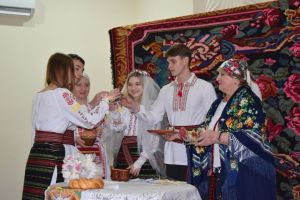 336160
336160
Lenten Dishes

A lot of people fast under the influence of the Church and ancient customs. Most Moldavians try to fast during the periods specified by the church before Christmas and Easter.
In the old days, during fasts peasants avoided even touching the bowl, where non-lean food was prepared; housewives in villages had separate utensils for cooking lean foods. Today this tradition is mostly observed in monasteries.
During the fast it was forbidden to eat animal products; only vegetables, including oil, were permitted. In the earlier days the Moldavians used pumpkin, sesame, and walnut butter for cooking lean food; later they began to use sunflower oil. Nowadays sunflower, corn and olive oil are used for this purpose. Sunflower oil is produced even in rural vegetable oil processing facilities, while corn oil and olive oil can be bought only in stores.
During fasts the Moldavians, especially rural residents, have a special diet. In particular, during Advent the prepared dishes are:
Thick borscht with grits and sauerkraut.
1)Rinse grits thoroughly and put to boil
2)Add the chopped sauerkraut.
3)Cook the borscht on low heat to prevent grits from burning.
4)Cook the onion in oil on a pan till brown, and add it to borsch when grits are ready. The dish is to be served hot.
There are many other types of borscht: with beans, cabbage, peas, noodles, potatoes. There are varieties of bean dishes: boiled with onions, roasted, and crushed with garlic. Pies with pumpkin and cabbage, pitas with poppy seeds, dumplings with cabbage and potatoes, etc. that are also often cooked.
Pumpkin pies (verzare):
1)Skin the pumpkin and remove the seeds, grate it and sprinkle with sugar.
2)For the dough we will need white wheat flour, water and salt. Roll out a small piece of dough, spread the filling on the layer, and connect the edges so that pie turns round.
3)Then place it on a baking sheet and put into oven.
Pitas with poppy seeds:
1)Knead the dough using white flour and water, and add a little bit of salt.
2)Roll out the pita layers 2-3 mm thick and put into oven.
3)Allow pitas to cool, then cut into pieces, put in a bowl and sprinkle with sweetened water. Mash the poppy seeds with sugar until liquid begins to come out of them.
4)Add some water to the mixture, and then pour it on the pitas. This dish is served for a funeral dinner or a festive table during the fasts.
Kyselica: Various dried fruits (apples, plums, pears) are cooked in water adding sugar to taste. Kyselica is served cold.
Dough in oil:
1)Knead the dough from flour and water.
2)Roll out the layer 2-3 mm thick, then cut it into strips 2 cm wide and 10 cm long, boil in salted water, put in a bowl and pour oil with onion fried in it.
Same dough can be used for making dumplings with cabbage, potatoes, cherries, jam, etc.
Cooked pumpkin:
1)Skin the pumpkin and remove the seeds.
2)Cut into small pieces and simmer in a small amount of water.
3)When ready, sprinkle the pumpkin pieces with sugar and serve.
Roasted pumpkin: Skin the pumpkin, cut into small pieces, sprinkle with sugar or honey, and put it in the oven. It could be served either hot or cold.
Fasting dishes are cooked for Christmas Eve as well. They include traditional, well known since ancient times recipes made out of basic agriculture food products. People believed that having these dishes on Christmas Eve table secures a good harvest in the coming year. The Christmas Eve meal for peasants was cooked from cereals, vegetables and fruits grown in their own farms: wheat, beans, chickpeas, cabbage, peas, potatoes, apples, pears, plums, etc. The number of dishes on Christmas Eve has to be magic - 7, 9, and 12.
Koliva, cabbage rolls with corn grits, pies, tortillas with poppy seeds, beans, kidney beans, and cooked plums have to be served on Christmas Eve. All these dishes had a symbolic meaning.
In particular, according to a legend, koliva - boiled wheat with sugar or honey, chopped nuts and poppy seeds - was blessed by the Virgin Mary as a celebratory meal. Pitas with poppy seeds were regarded as a symbol of the swaddles that baby Jesus was wrapped in.
Seven-week Fasting is considered the time of physical and spiritual cleansing before the main Christian holiday - Easter. It means not only abstaining from such non-lean food as meat, milk, eggs, alcohol, but also doing good deeds, charity, forgiving neighbors, etc. The Moldavians follow these traditions since ancient times. During this period the food is supplemented with green vegetables that start appearing in the spring harvest: nettle, sorrel, wild garlic, etc.
Here are the dishes usually cooked during Fasting:
Borscht with spring nettle: Ingredients: 2 liters of water, 2-3 potatoes, 1 carrot, 1 onion, 1 bunch of nettle, 100 g of rice, 40 g of butter, parsley, dill.
1)Cut potatoes into cubes and boil with rice.
2)Fry chopped onion and carrot in vegetable oil.
3)Thoroughly rinse nettle, scald and finely chop. When the rice and potatoes are ready, add nettle and fried onion and carrot, pour some sour kvass, and sprinkle on top with parsley and dill.
4)This dish is served hot.
Tokana with nettle:
1)Rinse spring nettle, boil for 3-5 minutes and finely chop.
2)Sauté chopped onions, then add nettle. When nettle is ready, add 1 tbsp of flour, pour in a little water, stir, add some salt and allow to simmer for a few minutes.
3)Crushed garlic adds flavour to tokana. The dish is served hot as well as cold.
Lean rolls: We will need rice, carrots, onions, tomato paste, salt, and ground black pepper.
1)Chop onion finely and fry in butter, then add grated carrots.
2)Stew onions and carrots a bit, and then add a spoonful of tomato paste.
4)Combine the mixture with the pre-rinsed rice, and add salt and pepper. Wrap the staffing in sorrel, maple, or coltsfoot leaves.
Pilaf with leeks:
1)Clean leek stalks, cut them into slices, and fry in oil in the casserole.
2)Then add 300 g pre-rinsed rice and fry it too.
3)Add a spoonful of tomato paste, salt and pepper. Add water to the mixture, cover with a lid and put in the oven for 20 minutes. Pilaf is served hot.
Appetizer with nettle and nuts:
1)Rinse thoroughly 800 g of nettle and boil it in salted water.
2)Then chop it finely, fry in oil, add salt, pepper and some water, in which nettle was boiled.
3)At the end, mix with chopped nuts.
Fasting cookies: We will need flour, a cup of sour kvass or tomato pickle water, a cup of vegetable oil, a cup of sugar, a spoonful of soda slaked in vinegar.
1)Make tight dough with these ingredients, and cut it into pieces with a cutting wheel or grind it through a meat grinder using special mincing screen.
2)Bake the cookies in the oven.
Potato pudding: Ingredients: 600 g of potatoes, 2 onions, 100 g of oil, 2 tbsp of flour, 2 cloves of garlic, salt, pepper. 1)Cook peeled potatoes with chopped onions, mash it, and add butter, salt, pepper and flour.
2)Put the mixture into baking dish, sprayed with oil and sprinkled with rusk flour, and put in oven.
3)When ready, sprinkle the pudding with crushed garlic and serve it hot.
Unlike any other nation, the Moldavians protect their tradition of cooking dishes from salad leaves and vegetables. Salads, tokanas, givechi, borschts, and soups have been always highly valued in the Moldavian national cuisine.
În contextul lansării programului ”Satul European”, ce probleme vitale există în localitatea dumneavoastră?
- Statut:
- Sat
- Prima atestare:
- 1921
- Populația:
- 2190 locuitori
Petrunea este un sat şi comună din raionul Glodeni. Petrunea este unicul sat din comuna cu acelaşi nume. Localitatea se află la distanța de 5 km de orașul Glodeni și la 167 km de Chișinău. Conform datelor recensămîntului din anul 2004, populaţia satului constituia 2190 de oameni. Satul Petrunea a fost înființat în anul 1921.





 15 noiembrie - Calendarul celor mai importante evenimente din trecut și prezent
15 noiembrie - Calendarul celor mai importante evenimente din trecut și prezent  MELODIA ZILEI: Anatol şi Irina Bivol - Ileana și Constantin
MELODIA ZILEI: Anatol şi Irina Bivol - Ileana și Constantin  Loviți de secetă! Fermierii au obținut o recoltă mai mică de floarea-soarelui
Loviți de secetă! Fermierii au obținut o recoltă mai mică de floarea-soarelui  Moldografia: Clădirea conacului moșiei Vila Mîndîc
Moldografia: Clădirea conacului moșiei Vila Mîndîc  Persoanele cu maladii oncologice beneficiază mai rapid de investigații de înaltă…
Persoanele cu maladii oncologice beneficiază mai rapid de investigații de înaltă…  Adunarea ţării în Moldova la 582 de ani
Adunarea ţării în Moldova la 582 de ani  În municipiul Chișinău va fi inaugurat Centrul de Monitorizare a Traficului
În municipiul Chișinău va fi inaugurat Centrul de Monitorizare a Traficului  Marica Balan – o legendă a scenei
Marica Balan – o legendă a scenei  REŢETA ZILEI: Cumaci - pîine cu umplutură de brînză
REŢETA ZILEI: Cumaci - pîine cu umplutură de brînză  Dimitri Ciubașenko: „Maia Sandu încearcă să oprească căderea sa ulterioară”
Dimitri Ciubașenko: „Maia Sandu încearcă să oprească căderea sa ulterioară”  Moldovenii – temelia ţării
Moldovenii – temelia ţării  Vladimir Panfilov: „În 1992 nu a existat suficientă înțelepciune pentru a negoci…
Vladimir Panfilov: „În 1992 nu a existat suficientă înțelepciune pentru a negoci…  71 de ani de la nașterea protoiereului mitrofor, Mihail Panas
71 de ani de la nașterea protoiereului mitrofor, Mihail Panas  Rîul Ciuhur de la izvor pînă la vărsare (Slideshow)
Rîul Ciuhur de la izvor pînă la vărsare (Slideshow)  16 noiembrie - Calendarul celor mai importante evenimente din trecut și prezent
16 noiembrie - Calendarul celor mai importante evenimente din trecut și prezent  Ce evenimente culturale vor avea loc în ziua de 16 noiembrie
Ce evenimente culturale vor avea loc în ziua de 16 noiembrie  Moldografia: Vedere spre satul Pociumbeni, Rîșcani
Moldografia: Vedere spre satul Pociumbeni, Rîșcani  Victoria moldovenilor la Cătlăbuga
Victoria moldovenilor la Cătlăbuga  Liceul „Ștefan cel Mare” și muzeul Drochia, împreună pentru a păstra tradițiile…
Liceul „Ștefan cel Mare” și muzeul Drochia, împreună pentru a păstra tradițiile…  Cum pot fi utilizate frunzele uscate
Cum pot fi utilizate frunzele uscate 